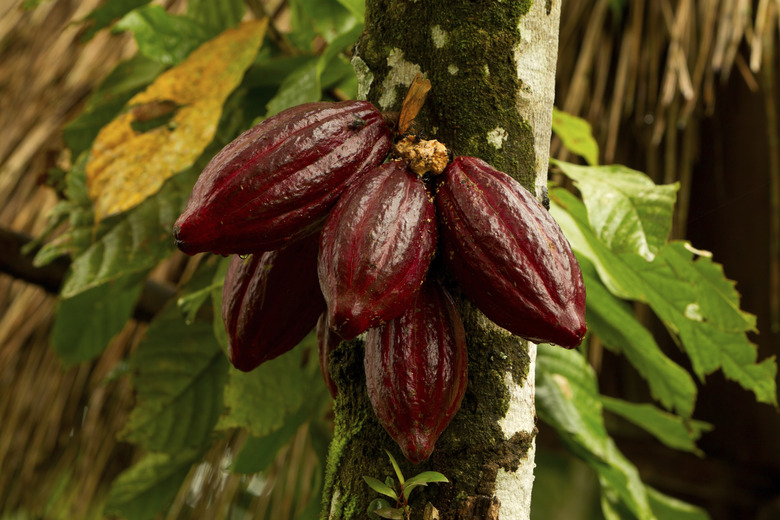How To Grow Cocoa Beans
Many chocolate lovers would like to grow their own "food of the gods," which is the interpretation of the cocoa tree's (Theobroma cacao) genus name. That is possible in areas no farther than 20 degrees in latitude from the equator or in U.S. Department of Agriculture plant hardiness zones 11 to 13. For U.S. gardeners, the tree should survive outdoors in much of Hawaii and parts of southern Florida and southern California, as well as tropical U. S. territories such as Puerto Rico. In colder zones, it may be grown under warm and humid conditions as a houseplant.
Knowing the Cocoa Tree
Native to South and Central America and sometimes reaching over 50 feet in the wild, the cocoa tree is generally restricted to half that height or less under cultivation. Because it grows best in partial shade, it must be kept shorter than the trees providing its canopy. Its glossy leaves, which can reach up to 2 feet in length, emerge a reddish shade and age to green. The tree's small pink or white flowers appear in clusters on plant tissue "cushions" on the tree's trunk or lower branches, most often during spring and summer. After pollination, those flowers develop into bean-filled, ridged pods, up to 14 inches long, which ripen to yellow or red in fall and winter.
Sowing the Cocoa Tree
To start your own tree, acquire seeds that are still in the pod or have been kept damp since their removal from it. The 3/4 to 1 1/2-inch "beans" lose viability after one to three months or if they are allowed to dry out. They often begin to sprout a single short tap root each while they are still in the pod. If your seeds aren't showing roots yet, place them between damp paper towels in a warm place — preferably with temperatures in the 80s Fahrenheit — until they do. Then pot them up in individual 4-inch tree pots of damp seed-starting mix, positioning each seed vertically with the root end down and the opposite end just beneath the surface of the mix. Cover the pots with plastic wrap and set them on a seedling heat mat to keep their temperature in the 80s until the seeds sprout, which should take five to 10 days. After removing the plastic wrap, place the seedlings on a partially shaded windowsill or under the end of a grow light.
Stowing the Cocoa Tree
Continue to transplant your cocoa seedlings into larger pots of potting soil as necessary, never allowing their soil to completely dry out, and keeping them at temperatures between 65 and 85 degrees. Fertilize them every two weeks from spring through fall with a scentless fish emulsion such as 2-4-1, mixing 1 tablespoon with each gallon of water. To transplant a cocoa tree that is at least 2 feet tall outdoors in the spring, choose a location in humus-rich, well-drained soil with a pH near 6.5. The site should be about 10 feet from a taller evergreen tree that will provide partial shade and protect the cocoa tree from wind. After digging a hole three times the depth and diameter of the cocoa tree's root ball, return two-thirds of the loose soil to the hole. Remove the tree from its pot and position it atop the mound at the same level at which it grew in the pot. After you finish filling in the soil around the roots, water the tree well and cover the ground around it with a 2- to 6-inch layer of mulch, keeping that mulch at least 8 inches away from the trunk.
Growing the Cocoa Tree
The tree will need 1 to 2 inches of water per week but don't allow its soil to become soggy, as it is vulnerable to root rot. Give it 1/8 pound of 6-6-6 organic fertilizer every two weeks, increasing that to 1 pound of fertilizer every two months after the tree is a year old. It should begin to flower when it is 3 or 4 years old, generally after it has reached about 5 feet in height and has begun to branch out. For the best cocoa bean production, hand pollinate the flowers in the early morning. Keep in mind that many of the pods naturally shrivel without developing, and that no more than two should be left growing from each cushion. When ripe, the beans require extensive processing — including fermenting, roasting and grinding — to turn them into chocolate.
References
- World Agroforestry Centre: Growing Cocoa Beans
- Growing Tasty Tropical Plants; Laurelynn G. Martin and Byron E. Martin
- Purdue University: Theobroma cacao L.
- Hawaiian Tropical Plant Nursery LLC: Edible Plants
- The Encyclopedia of Seeds: Science, Technology and Uses; J. Derek Bewley, Michael Black and Peter Halmer, Editors
- University of Florida IFAS Extension: Cocoa (Chocolate Bean) Growing in the Florida Home Landscape
- Trade Winds Fruit: Cacao
- USDA Agricultural Resource Service: USDA Plant Hardiness Zone Map
